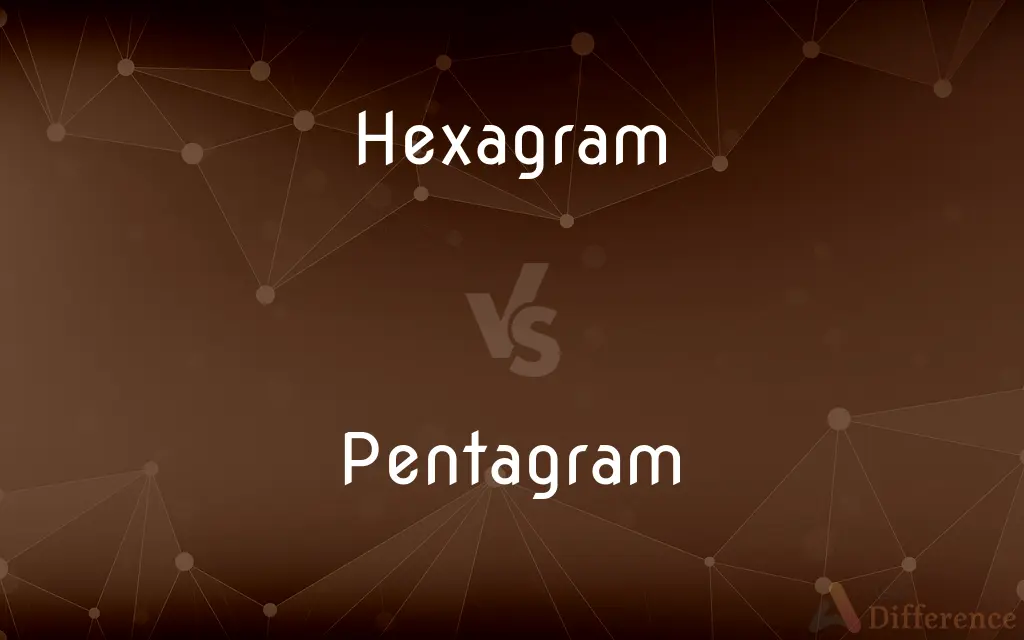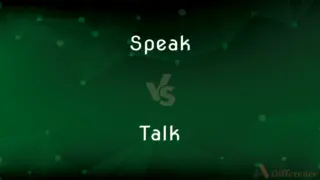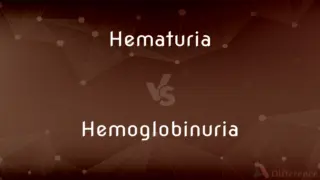Hexagram vs. Pentagram — What's the Difference?
Edited by Tayyaba Rehman — By Maham Liaqat — Updated on March 10, 2024
Hexagrams consist of six points or lines, often symbolizing harmony; pentagrams have five, commonly associated with magic or protection.

Difference Between Hexagram and Pentagram
Table of Contents
ADVERTISEMENT
Key Differences
Hexagrams are geometric shapes with six points or lines, forming a star-like symbol. This figure is widely recognized in various cultures, often symbolizing harmony, balance, and unity. In Judaism, the hexagram is known as the Star of David, representing the connection between the divine and the earthly. On the other hand, pentagrams consist of five points or lines and have been used throughout history in different contexts.
Hexagrams are sometimes used in mathematical contexts or in games and puzzles, showcasing their versatility beyond spiritual or cultural symbolism. Whereas pentagrams have found their way into popular culture, often depicted in movies, books, and tattoos to signify mysticism, protection, or a connection to nature.
While the hexagram's use in religious and cultural symbols emphasizes unity and the intersection of opposites, the pentagram's associations with magic and protection highlight the human desire for control and understanding of the unseen forces of the world.
Comparison Chart
Points/Lines
6
5
Symbolic Meaning
Harmony, balance, divine connection
Magic, protection, spirituality
ADVERTISEMENT
Cultural Significance
Star of David, unity
Wiccan and pagan symbols, mysticism
Use in Popular Culture
Less common, mainly religious contexts
Widely recognized in movies, tattoos, etc.
Orientation and Interpretation
Less emphasis on orientation
Orientation can signify different meanings
Compare with Definitions
Hexagram
A six-pointed geometric star figure.
The hexagram is often associated with the Star of David in Jewish tradition.
Pentagram
A five-pointed star with interconnected lines.
The pentagram was engraved on the ancient temple's entrance.
Hexagram
Appears in games and puzzles as a complex shape.
The puzzle involved arranging hexagrams to form a larger pattern.
Pentagram
Often associated with magic, protection, and spiritualism.
She wore a pentagram necklace as a symbol of protection.
Hexagram
Used in various cultures and beliefs.
In some Eastern philosophies, the hexagram symbolizes the union of opposites.
Pentagram
Used in Wiccan and pagan practices.
The ceremony included the drawing of a pentagram for protection.
Hexagram
Symbolizes harmony, balance, and unity.
The hexagram on the flag represented the country's aim for peace.
Pentagram
Has various meanings based on orientation.
The upward-pointing pentagram was a symbol of positive energy.
Hexagram
Represents the intersection of the divine and earthly realms.
The temple's hexagram mosaic highlighted its spiritual significance.
Pentagram
Featured in popular culture as a mystical symbol.
The movie's protagonist used a pentagram to cast spells.
Hexagram
A hexagram (Greek) is a six-pointed geometric star figure with the Schläfli symbol {6/2}, 2{3}, or {{3}}. Since there are no true regular continuous hexagrams, the term is instead used to refer to a compound figure of two equilateral triangles.
Pentagram
A pentagram (sometimes known as a pentalpha, pentangle, pentacle or star pentagon) is the shape of a five-pointed star polygon. Pentagrams were used symbolically in ancient Greece and Babylonia, and are used today as a symbol of faith by many Wiccans, akin to the use of the cross by Christians.
Hexagram
A six-pointed star formed by extending each of the sides of a regular hexagon into equilateral triangles.
Pentagram
See pentacle.
Hexagram
A figure of six lines or sides.
Pentagram
The shape of a five-pointed star constructed of five intersecting lines meeting at the vertices, such that a central pentagon and five surrounding isosceles triangles are formed; often with magical connotations; a 5/2 (or 5/3) star polygon.
Hexagram
A hollow six-pointed star formed by overlapping two equilateral triangles.
Pentagram
A pentacle or a pentalpha.
Hexagram
Any of the 64 sets of solid and broken lines, formed by pairs of trigrams, used for divination in the I Ching.
Pentagram
A star with 5 points; formed by 5 straight lines between the vertices of a pentagon and enclosing another pentagon
Hexagram
A large silver coin minted during the Byzantine Empire.
Hexagram
A figure of six lines
Hexagram
A regular polygon formed by extending each of the sides of a regular hexagon to form two equilateral triangles
Common Curiosities
How are hexagrams used in culture?
Hexagrams are used in various cultural and religious contexts, such as the Star of David in Judaism.
What does a pentagram represent?
A pentagram commonly represents magic, protection, and spiritualism.
Can the orientation of a pentagram change its meaning?
Yes, the orientation of a pentagram can signify different meanings, with the upward point often representing positivity.
Are hexagrams found in nature?
Hexagrams can represent natural structures and relationships but are less commonly found in nature compared to human-made symbols.
How do hexagrams and pentagrams differ in symbolic meaning?
Hexagrams often symbolize unity and balance, whereas pentagrams are more closely associated with magic and protection.
What is a hexagram?
A hexagram is a six-pointed geometric figure, often symbolizing harmony and balance.
What is the significance of a pentagram in modern times?
In modern times, pentagrams are associated with Wiccan and pagan beliefs, symbolizing protection and connection to nature.
What is the cultural significance of the hexagram?
The hexagram holds significant cultural importance, particularly in Judaism, symbolizing divine-human connection.
How is the hexagram used outside of religious symbolism?
Outside of religious symbolism, hexagrams can be seen in puzzles, games, and as a symbol of harmony in various philosophical contexts.
Is the pentagram always associated with negative connotations?
No, the pentagram is not always associated with negative connotations; its meaning varies with context and culture.
How do popular culture portray pentagrams?
Popular culture often portrays pentagrams as symbols of mysticism, magic, or occultism.
Do hexagrams have a specific orientation like pentagrams?
Hexagrams do not typically emphasize orientation for symbolic meaning as pentagrams do.
Are pentagrams exclusive to any single belief system?
No, pentagrams are not exclusive to any single belief system; they appear in various religions, cultures, and spiritual practices.
Can both symbols be used in religious contexts?
Yes, both symbols can be used in religious contexts, but their meanings and associations differ widely.
What does the upward-pointing pentagram symbolize?
An upward-pointing pentagram generally symbolizes positive energies, protection, and connection to the divine.
Share Your Discovery

Previous Comparison
Speak vs. Talk
Next Comparison
Hematuria vs. HemoglobinuriaAuthor Spotlight
Written by
Maham LiaqatEdited by
Tayyaba RehmanTayyaba Rehman is a distinguished writer, currently serving as a primary contributor to askdifference.com. As a researcher in semantics and etymology, Tayyaba's passion for the complexity of languages and their distinctions has found a perfect home on the platform. Tayyaba delves into the intricacies of language, distinguishing between commonly confused words and phrases, thereby providing clarity for readers worldwide.
















































